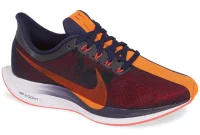The athletic footwear industry is experiencing trailblazing trends with innovative designs, technologies, and materials. From sustainable sneakers made of recycled materials to customizable shoes with 3D-printed soles, the options for athletes are endless. Explore the future of athletic footwear as brands push boundaries to enhance performance and style.
Emerging Innovations in Sports Shoes
The world of athletic footwear is constantly evolving with new and emerging innovations that aim to enhance performance and comfort for athletes. These trailblazing trends in sports shoe technology are revolutionizing the way athletes train, compete, and even prevent injuries. Let’s take a look at some of the most exciting advancements in sports shoes today.
1. Lightweight Materials
One of the key trends in athletic footwear is the use of lightweight materials. Companies are constantly researching and developing materials that are not only durable but also incredibly light, allowing athletes to feel more agile and swift during their performance. Advanced synthetic materials and mesh combinations provide excellent breathability while minimizing weight.
2. Enhanced Cushioning
Another important innovation is the improvement of cushioning systems in sports shoes. Brands are incorporating advanced foam technologies, such as air or gel cushioning, to provide superior shock absorption and energy return. These developments help reduce the impact on joints and muscles, ultimately enhancing overall comfort and minimizing the risk of injuries.
3. Customized Fit
Sports shoe manufacturers are increasingly offering customizable fit options. The introduction of 3D foot scanning and printing technologies allows athletes to create shoes tailored specifically to their foot shape and biomechanics. This personalized approach ensures optimal fit, support, and stability, enhancing overall performance and reducing the risk of discomfort or injury.
4. Smart Shoe Technology
The integration of smart technology into sports footwear has opened up a whole new world of possibilities. Sophisticated sensors embedded within the shoes can track various performance metrics, including steps, distance, speed, and even foot strike patterns. This data can be analyzed to provide valuable insights and help athletes improve their training techniques and performance.
5. Sustainable Materials
As environmental awareness grows, so does the demand for sustainable sports shoe options. Brands are now exploring eco-friendly alternatives, such as recycled materials, bio-based polymers, and plant-based fabrics. By adopting these sustainable practices, companies are not only reducing waste but also addressing the growing concern for environmental conservation.
As we can see, the future of athletic footwear lies in constant innovation. Lightweight materials, enhanced cushioning, customized fit options, smart technology, and sustainable materials are all contributing to the trailblazing trends in sports shoes. These advancements are not only revolutionizing the athletic performance but also ensuring the well-being and satisfaction of athletes worldwide.
The Importance of Sustainable Practices in Shoe Manufacturing
In recent years, the fashion industry has witnessed a growing demand for sustainable practices across all sectors, including shoe manufacturing. This shift towards sustainability is particularly pronounced in the athletic footwear industry, driven by consumer awareness and a desire for products that align with their values.
One key reason why sustainable practices are crucial in shoe manufacturing is the environmental impact of the industry. Traditional manufacturing methods often involve high resource consumption, excessive waste generation, and harmful chemical usage. By adopting sustainable practices such as using eco-friendly materials, reducing energy consumption, and implementing efficient waste management systems, shoe manufacturers can significantly minimize their ecological footprint.
Moreover, sustainable practices in shoe manufacturing also contribute to a cleaner and healthier environment. By utilizing recycled materials, manufacturers reduce the need for new resource extraction and limit landfill waste. Additionally, implementing renewable energy sources and reducing carbon emissions from production processes help combat climate change and improve air quality.
Not only do sustainable practices benefit the environment, but they also showcase social responsibility. Many shoe manufacturers are now prioritizing fair labor practices, ensuring safe working conditions, and promoting ethical sourcing of materials. This not only boosts the brand’s reputation but also fosters positive relationships with consumers who value ethical and transparent business practices.
Furthermore, integrating sustainable practices into shoe manufacturing can lead to innovation and product differentiation. Brands that actively pursue eco-friendly initiatives often discover new materials and manufacturing techniques that result in high-performing, durable, and stylish athletic footwear. This allows them to stay ahead of the competition and cater to the needs of environmentally conscious consumers.
In conclusion, the importance of sustainable practices in shoe manufacturing cannot be overstated. Beyond reducing the industry’s environmental impact, these practices contribute to a cleaner environment, demonstrate social responsibility, and drive innovation. As consumers increasingly prioritize sustainability, embracing eco-friendly practices is not only essential for the success of shoe manufacturers but also for the well-being of our planet.
Analyzing Athlete Feedback in Shoe Design
Athletic footwear design has rapidly evolved over the years, as manufacturers strive to meet the diverse needs and preferences of athletes. In this article, we will delve into the significance of analyzing athlete feedback in the process of shoe design, particularly in the realm of trailblazing trends.
1. Design Customization
One of the key takeaways from athlete feedback is the demand for shoe customization. Athletes have varying foot shapes, sizes, and arch types, leading to individual requirements and preferences in footwear. By incorporating customization features, such as adjustable lacing systems, removable insoles, and personalized cushioning, shoe designers can enhance comfort and performance.
2. Lightweight Materials
Athletes consistently express their desire for lightweight footwear that doesn’t compromise durability. Through athlete feedback, shoe designers have been inspired to explore innovative materials, such as lightweight mesh uppers, carbon fiber soles, and foam-based midsoles. These advancements provide athletes with the necessary support and stability while keeping the shoes feather-light.
3. Traction and Grip
Athletic activities often take place in various terrains, requiring reliable traction and grip. Athlete feedback highlights the importance of developing outsoles with patterned grips, specialized rubber compounds, and multidirectional lugs. This allows athletes to confidently navigate challenging surfaces, whether it be rocky trails or wet pavements.
4. Breathability and Moisture Management
Excessive heat and moisture can cause discomfort and affect performance during intense physical activities. Analyzing athlete feedback has led to the incorporation of breathable mesh materials, moisture-wicking linings, and ventilation systems in modern shoe designs. These features enable effective airflow, keeping athletes’ feet dry, cool, and comfortable.
5. Versatile Footwear
Athletes often value versatility in their footwear, seeking shoes that can transition seamlessly between different sports or activities. By considering athlete feedback, shoe designers have developed multi-sport shoes with versatile designs, offering adaptable features for running, hiking, cross-training, and more. This trend ensures athletes can invest in a single pair of shoes that meet their diverse athletic needs.
In conclusion, athlete feedback plays a pivotal role in driving innovation and shaping the trailblazing trends observed in modern athletic footwear. By listening and responding to athletes’ needs and preferences, shoe designers can create products that excel in comfort, performance, and functionality.
The Intersection of Technology and Comfort
In the rapidly evolving world of athletic footwear, there is a clear and exciting trend emerging – the intersection of technology and comfort. As athletes and fitness enthusiasts seek to enhance their performance and maximize their comfort levels, footwear brands are pushing the boundaries to meet these demands.
One key aspect of this trend is the integration of advanced technologies. Shoe manufacturers are incorporating cutting-edge features such as responsive cushioning systems, energy return technologies, and motion control capabilities. These technologies not only provide superior comfort but also enhance performance by optimizing energy transfer, reducing impact, and enhancing stability.
Another important factor in this trend is the use of innovative materials. Companies are embracing the use of lightweight, breathable, and flexible materials that offer a glove-like fit. These materials are not only comfortable but also contribute to overall foot health by allowing for proper airflow and reducing the risk of blisters or discomfort caused by friction.
Additionally, customization options are becoming increasingly prevalent in athletic footwear. Brands recognize that each individual has unique foot anatomy and preferences, and they are catering to this by offering customizable features such as insole inserts, adjustable lacing systems, and personalized fit options. This level of tailoring ensures that athletes can find the perfect fit for their specific needs.
Furthermore, style and aesthetics have not been neglected in this trend. Manufacturers are striving to create stylish and visually appealing designs without compromising on performance or comfort. Athletes no longer have to choose between functionality and fashion; they can have the best of both worlds.
As the trailblazing trends in athletic footwear continue to evolve, we can expect further advancements in technology, materials, customization, and style. The pursuit of comfort and enhanced performance is driving innovation in the industry, and athletes worldwide are reaping the benefits.
Celebrity Athletes and Their Signature Shoes
In the world of sports, many professional athletes have ventured beyond their athletic achievements and left a lasting impact on the fashion industry. One notable trend that has emerged is the collaboration between celebrity athletes and renowned sportswear brands to create signature shoes. These shoes not only reflect their unique persona but also cater to the needs of aspiring athletes and fashion enthusiasts alike.
The phenomenon of celebrity athletes having their own signature shoes began with basketball superstar Michael Jordan, who partnered with Nike in the mid-1980s to launch the iconic Air Jordan line. Known for its distinctive design and innovative technology, the Air Jordan series revolutionized the way people perceive athletic sneakers. It also paved the way for other athletes to follow suit and make a mark in the sneaker industry.
Today, we see an array of celebrity athletes with their own signature shoes across various sports. LeBron James, a prominent figure in the NBA, collaborated with Nike to produce the LeBron series, which combines style and performance. Similarly, tennis sensation Serena Williams partnered with Nike to create the Serena Williams collection, empowering athletes on and off the court.
Aside from basketball and tennis, other sports have also seen their share of signature shoes. Soccer star Cristiano Ronaldo teamed up with Nike to release the CR7 line, embodying his speed and elegance on the field. NFL quarterback Tom Brady collaborated with Under Armour to design the UA TB12, a shoe that caters to the unique demands of football players.
The influence of celebrity athletes’ signature shoes extends beyond the realm of professional sports. These shoes have become fashion statements, coveted by sneaker enthusiasts and collectors worldwide. The limited edition collaborations between athletes and brands often sell out quickly, creating a sense of exclusivity and rarity.
In conclusion, the trend of celebrity athletes developing their own signature shoes has become a defining aspect of modern athletic footwear. These collaborations not only showcase the individual’s personality and style but also inspire aspiring athletes and captivate fashion-conscious consumers. With each new release, the fusion of athletic performance and fashion continues to set trailblazing trends that shape the future of footwear.
Conclusion
In conclusion, the athletic footwear industry continues to evolve with innovative trends that cater to the needs of athletes and consumers. From the rise of sustainable materials and minimalist designs to the integration of advanced technology and customization options, athletes can now enjoy enhanced performance and comfort. As the market becomes more competitive, it will be intriguing to witness how these trailblazing trends pave the way for the future of athletic footwear.




